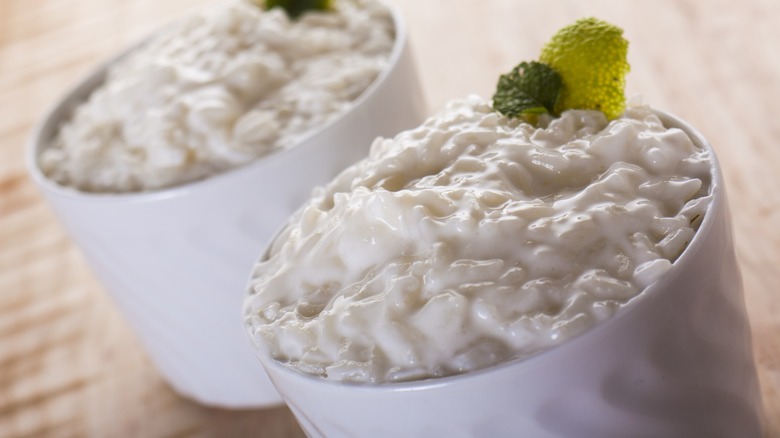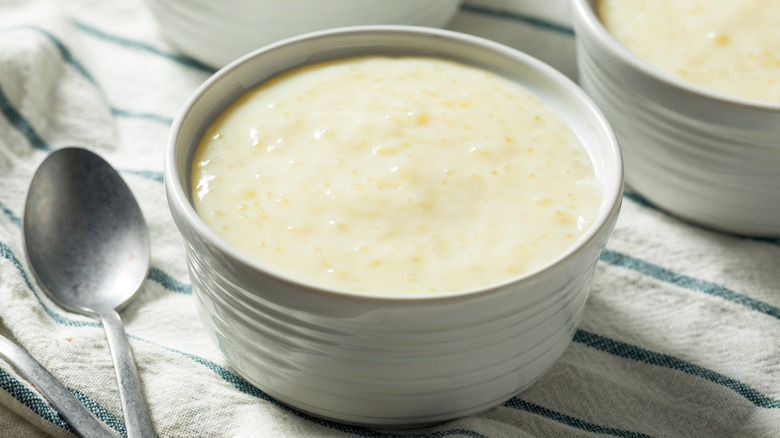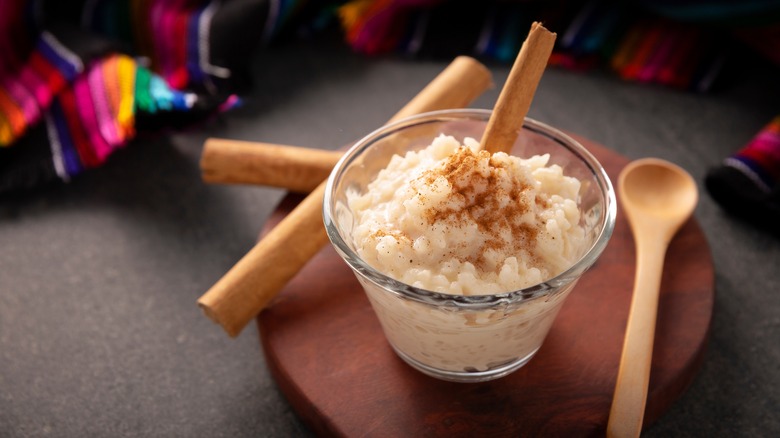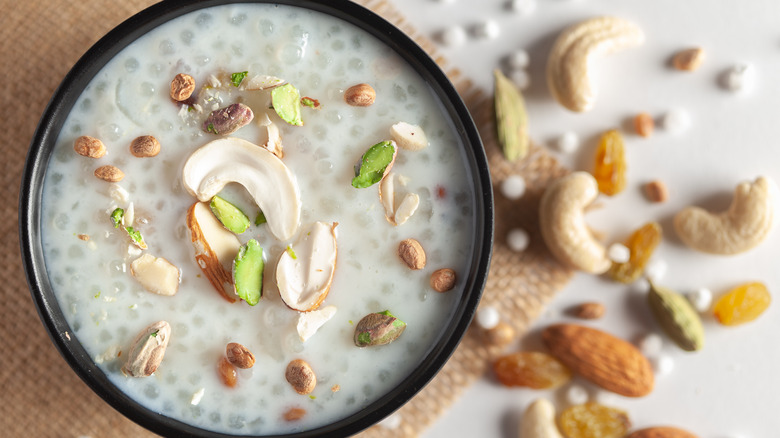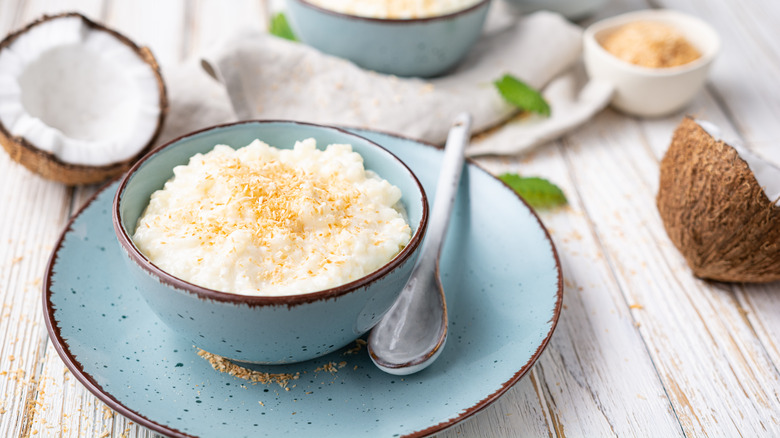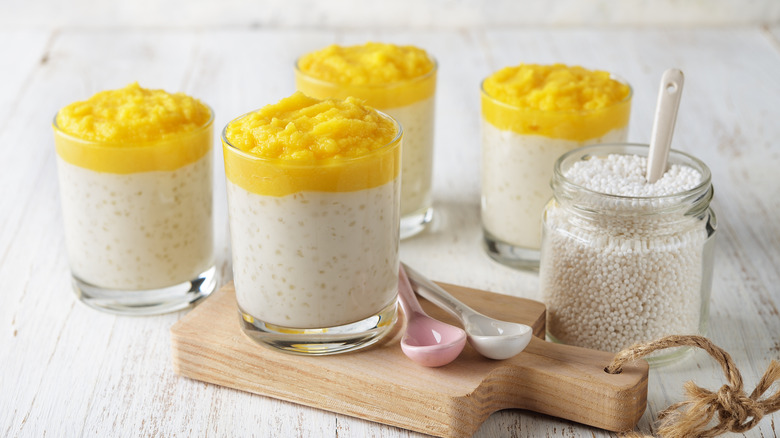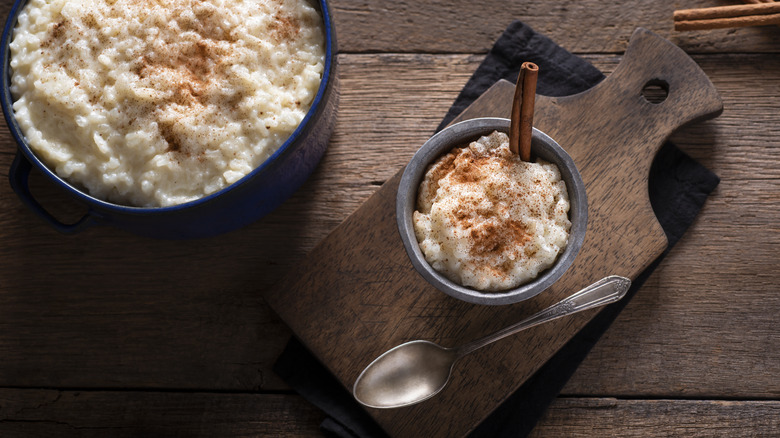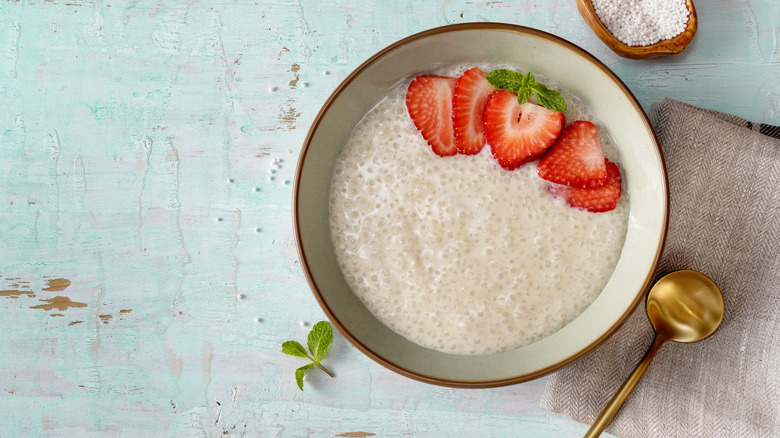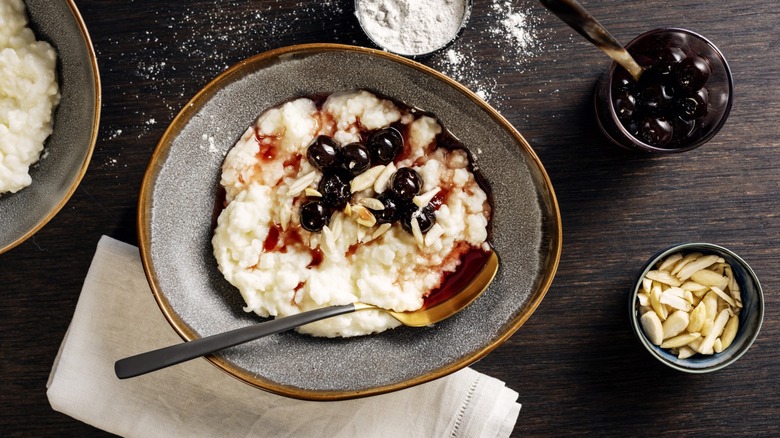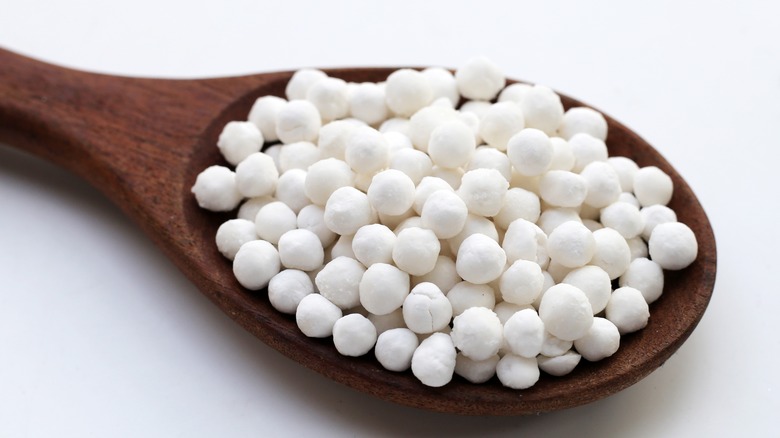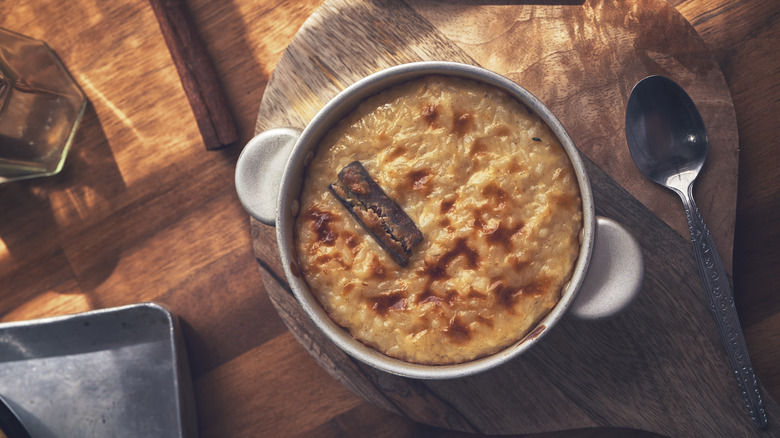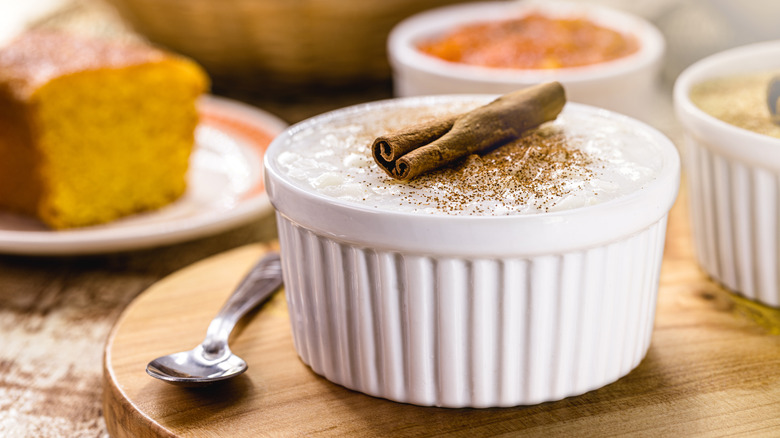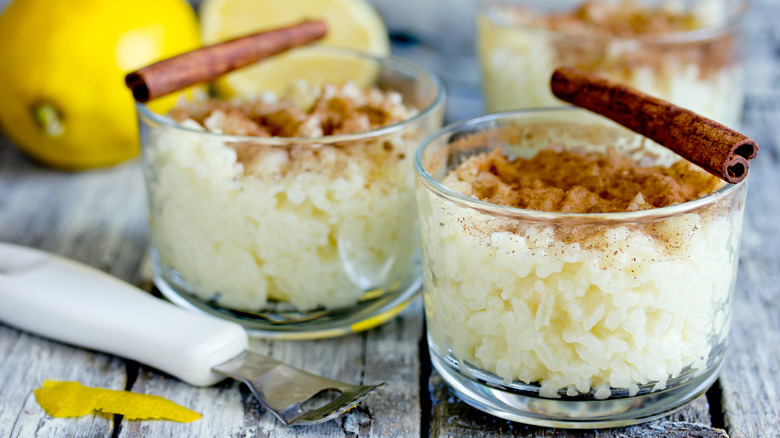Tapioca Vs Rice Pudding: Everything You Need To Know
Tapioca and rice pudding are two age-old desserts that never seem to disappear completely from the culinary scene, though the popularity of the former has waned in recent years. Even in their simplest forms, these two concoctions are comforting treats that often evoke nostalgia. They're also some of the easiest recipes to create, making them great choices for when you're in the mood for the sweet stuff, but don't want to spend hours in the kitchen.
On the surface they may seem very similar, but what distinguishes tapioca from rice pudding and vice versa? Which one might be more suitable for the confectionary ideas you have in mind? If you're looking for the scoop on this pair of comparable creations, we've got you covered when it comes to the differences in taste and texture, and how you can elevate your desserts beyond their seemingly simple exterior. Whether learning about one or both for the first time or looking for some scintillating new tidbits, grab a spoon and dig into the facts about a pudding duo that never fails to sweeten a table.
What is tapioca pudding?
Even if you've never tasted tapioca pudding before, you've probably heard it mentioned as it comes with a reputation for causing love-hate feelings in anyone who's ever eaten it, with plenty of defenders and just as many who can't stand it. Tapioca pudding is a mix of tapioca pearls, a carbohydrate-rich starch with a high sugar content processed into spherical shapes that people either find enticing or disgusting. This form of tapioca is similar to what's used in boba or bubble tea, though boba pearls are much larger.
Though often confused for sago, a similar ingredient that comes from palm trees, tapioca itself is a sweet form of cassava, a root vegetable used for food in tropical regions. Though cassava root has been cultivated for thousands of years in South America, tapioca pudding became a ready staple in the U.S. when Bostonian cook Susan Stavers created the first version of the dessert, which could be prepared by home cooks in minutes. And who doesn't love an easy dessert recipe, even one as contentious as tapioca pudding? Stavers ground her tapioca in a coffee grinder, which allowed it to cook without soaking and produced a texture preferable to the more labor-intensive version, and one of the more controversial foods entered the world.
What is rice pudding?
Rice pudding is a simple grain dish made by cooking rice in milk or cream instead of water. The result is a thicker consistency dessert, sweetened with sugar and topped with fruit, nuts, and spices to become a sweet version of the usually savory rice. Like tapioca, rice pudding is easy to make, and the texture and palatable base flavor make it a soothing comfort food loved for generations.
As soon as rice made its way to Europe in the 11th century, formalized iterations of rice pudding began cropping up as a dish, though cultures around the world have been making versions of rice pudding for millennia. In its most basic form, rice pudding can be seen as a breakfast, lunch, or dinner food. Its hearty nature and sturdy form make it satisfying without being too filling, though the high carbohydrate and sugar content rules it out as a healthy option for particularly careful eaters. Whether you find it as part of a Mexican table, an Indian menu, or a Middle Eastern spread, the familiarity of rice pudding extends around the globe.
Tapioca pudding has a heavy vanilla flavor
Even with a relatively neutral flavor profile from the tapioca itself, tapioca pudding more often than not is found with a mellow, pleasant vanilla flavor. This may be a reason for many to label the dish as bland, though it's not terribly different from regular vanilla pudding or custard. Tapioca itself has no discernable flavor, so the pudding relies on flavorings from extracts, as well as milk and sweeteners. You may find additional ingredients lending their heft to the base substance, but most tapioca puddings you'll find in pre-made or recipe form stick to the traditional vanilla formulation.
Other cultures keep the vanilla handy in their tapioca, too. A wildly different take on the expected shape and form, Brazilian tapioca pudding reimagines the usual bowl of pudding into a flan, shaped in a ring pan and drizzled with caramel. Despite its distinctive presentation and exciting color, the flavoring used in the recipe is simply vanilla, with a hint of coconut, which is close enough to vanilla to blend in.
Rice pudding can take on a variety of flavors
In its barest interpretation, rice pudding is flavored with vanilla and usually cinnamon, sometimes with nutmeg added for a bit of complexity. But in its dreamiest forms, rice pudding can conform to practically unlimited add-ins to transform it into a much richer dish. Combinations such as rum and raisin topped with malted whip and hazelnuts, orange and cinnamon, and even chocolate can send simple rice pudding from the launch pad soaring into the dessert stratosphere. Even a dollop of jam, sliced fruit, or a drizzle of maple syrup can bring out a whole different side of this adaptable creation, allowing you to add your signature spin to the comforting classic.
Crafty cooks will see a traditional rice pudding recipe as the starting point for something more customizable. As an ingredient, rice is a blank canvas that invites exploration. When sugar, butter, and milk are added, the richness expands and makes space for almost any dessert flavor invention you can come up with. Think of rice pudding as a warm version of ice cream, something that's nice enough on its own, but easily transformed into a more special experience with a few well-chosen add-ins.
Tapioca has a beady texture
There's no mistaking the pebbly consistency and beady texture of tapioca pudding, whether store-bought or homemade, and it's like nothing else in the culinary world. The softened starch in the tapioca creates a pudding that doesn't break down entirely, leaving shrunken versions of the original pearls throughout the finished recipe. The result is a dessert that appears smoother than it feels on the tongue, filled with little bubbles that mash easily when chewed. For fans of tapioca pudding, breaking the beads while eating is an enjoyable part of the experience. Others find the texture odd and off-putting, comparing it to eating frog spawn or fish eyes.
The idea of pudding being a smooth substance is perpetuated by custard, which is silky in its purest form. The last thing you want is lumpy custard, and it is perhaps this association that leads many to think the lumpy texture of tapioca pudding is unpalatable. While it still won't appeal to all tastes, once you understand that the beads in tapioca are not just expected but necessary for the pudding's distinctive texture, the idea seems a lot less off-putting. Then it just comes down to personal preference and whether you can appreciate this simple, sweet pleasure for what it is.
Rice pudding has a mushy texture
If you've made your rice pudding properly, it will have a mushy texture rather than the al dente quality that undercooked rice is sometimes left with. This is due to the breakdown of the starches in the rice, which thickens the mixture and gives rice pudding its trademark soft substance punctuated by partially broken-down grains. The combination is a strangely enticing blend that doesn't achieve the distinctive beadiness of tapioca, nor does it strive for the silky smoothness of a custard. Rice pudding is happy to do its own thing, and it does it with personality and confidence, no matter how mushy it might get.
However, mushy pudding isn't everyone's favorite, and this gives rice pudding a bit of a negative reputation in the dessert world. The use of so few ingredients in such a basic manner can cast it in a non-gourmet light and drop it squarely in the category of folk dining or comfort food. More creative chefs know better, however. With a bit of creativity, the mushy basis of rice pudding can be dressed up to become a more dignified dish. But even in its mushiest form, there's nothing wrong with a humble recipe like rice pudding if it's to your taste.
Tapioca pudding has been much maligned through the decades
Tapioca pudding hasn't had an easy run as desserts go. For many, it was a runny replacement for better food, a dish that reminded diners of fish or frog eyes suspended in runny goo. Quality is a factor in whether you're likely to enjoy tapioca, as are the conditions under which you first encountered it — put it this way, if you ate a lukewarm bowl of it in a school cafeteria, you're unlikely to have pleasant memories of it. Along with rice pudding and semolina, tapioca was a staple of schools in England from the 1960s to the 1990s. Even into the 21st century, tapioca pudding has been voted as a sub-par dessert, seen as a terrible memory from school days long past that created an indelible impression.
Though once popular as a form of Jell-O pudding, tapioca pudding has had difficulty making any kind of comeback, let alone finding a permanent place in a modern diet. It's more likely to be viewed as food for the older generations or babies, due in part to its soft texture and easy digestibility making it an easy food for older and younger eaters to consume. Even a current search for gourmet versions of tapioca pudding returns the same basic recipe and shopping links to packages you're likely to find in your grandparents' fridge, seemingly confirming tapioca has fallen out of favor.
Rice pudding has been favorably viewed around the world
Unlike tapioca pudding, rice pudding is a beloved dish that symbolizes comfort and soothing cuisine. The dish is even included in cultural events during important times throughout the year, with ingredients tailored to reflect the region. Having rice as a staple grain used for other dishes may help rice pudding enjoy a better reputation than tapioca pudding. Knowing what rice is also helps make it more palatable in such a broken-down form, so even seeing it in a similar mushy state evokes a different feeling to tapioca. Even the word "tapioca" is somewhat mysterious, which isn't usually a good aspect for a dish to take on.
Seeing a bowl of rice pudding decorated with toppings that reflect the culture also helps tie this humble creation to the people and the region, providing it with roots. Caribbean rice pudding uses familiar flavors like lime and cinnamon to tie the recipe into the heritage, while Thai versions referred to as sticky rice include coconut milk and mango in a similar fashion. In India, rice pudding — called kheer — features cardamom and rose water for accents that reflect the native palate. With so many rice pudding variations found throughout the international community, it seems that rice pudding helps tie the cuisines of the globe together. It also means that there are plenty of different versions to try and flavors to experiment with.
Tapioca pudding requires tapioca pearls
Making your own tapioca pudding from scratch means finding tapioca pearls, as they are a staple in any recipe you choose. Even being something of a specialty item, you may be able to find them in your local grocery store in the baking aisle, depending on how extensive a selection of unique ingredients they offer. Well-known companies like Bob's Red Mill are stocked at Whole Foods and offer 24-ounce bags of tapioca pearls for around $6.39, depending on location. Amazon also carries a variety of brands, making it easy to give this dessert a test run without having to drive all over town to find it. And if you have an Asian market in your area, you're likely to find some there, too.
The increasing popularity of boba tea has made it easy to mistake the form of store-bought tapioca required for creating a dessert rather than a drink. It's important to note that you'll need small pearl tapioca when making pudding. The bags of larger pearls in stores may be perfect for boba, but they won't produce the quintessential texture you're looking for in a well-made tapioca pudding.
Rice pudding can be made from leftover rice
It isn't necessary to use uncooked rice to create rice pudding, though most recipes call for it. While there are certain rice grains that are better for rice pudding, if you end up with leftover rice from whatever dish you're preparing, you can transform it into rice pudding and give it a second life and a new place on your table.
The difference you may find in a cooked rice pudding is a few extra ingredients that help with texture without complicating flavor too much. A simple creation from All Recipes includes an egg and a bit of butter, both of which will thicken up and enrich the finished pudding. This can be forgiving of rice that may have gone dry before you've had a chance to make your pudding. Using whole milk will incorporate more fat for a creamier consistency while tossing in raisins will add textural variety that provides even more taste and interest in the finished dish.
Both puddings can be turned into fancier desserts
They may be desserts in their own right, but both tapioca and rice pudding can be the basis of a much sweeter creation. You can experiment with vegan versions of tapioca pudding made with coconut milk and dressed up with tropical fruit or use the pudding as the start of a peach pie instead of custard or pastry cream. If your culinary imagination tells you a recipe can make use of vanilla pudding, try replacing it with tapioca and see how much more interesting things can be.
With rice pudding, it's simply a matter of applying your baking knowledge to come up with warm dishes like coconut rice pudding with gingered pears and rice pudding dressed to the hilt with salted caramel. Try sprinkling crumbles of spice cake on top, embed apple pie filling in the center, or simply decorate the top with a drizzle of chocolate sauce. Your rice pudding will be all the better for it, and the simplicity of the base layer means the possibilities for experimentation are endless.
Both are available in ready-to-serve forms
If firing up your stove and shopping for a bunch of new ingredients just to try out tapioca or rice pudding sounds like something you'd rather not do, you can find pre-made versions in your local grocery store instead. Tapioca pudding is available in Snack Pack form, as well as in the refrigerator section from Kozy Shack, one of the better-known brands on the tapioca scene. You can also pick up dry versions from Jell-O and Minute Tapioca for a happy medium between ready-to-serve and simple-to-prepare. In addition to tapioca, Kozy Shack corners the pudding market by offering a packaged version of rice pudding, too.
Even if you opt for these pre-packaged versions, give your puddings a bit of a glow-up by adding extra spices, a sprinkle of nuts or chocolate chips, or a bit of sliced fruit. You may find that both tapioca and rice pudding are tasty, simplified desserts that give you something soothing to dig into when the need for something sweet arises.
